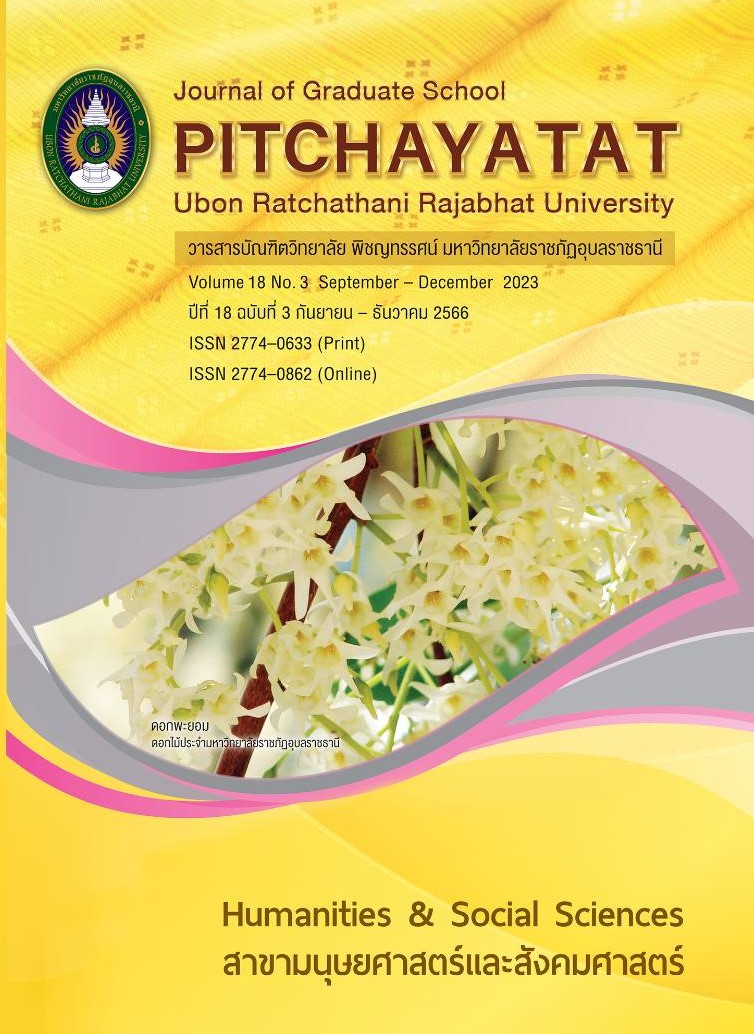การวิจัยและพัฒนาศักยภาพบุคลากรภาคการเกษตรของชุมชนจังหวัดเชียงใหม่อย่างสร้างสรรค์ สู่ประชาคมอาเซียน
คำสำคัญ:
ปริมาณผลผลิต , รายได้สุทธิ , ปริมาณพื้นที่เพาะปลูก , การพัฒนาศักยภาพ , ประชาคมเศรษฐกิจอาเซียนบทคัดย่อ
การวิจัยนี้มีวัตถุประสงค์เพื่อศึกษาศักยภาพและส่งเสริมการพัฒนาศักยภาพบุคลากรภาคการเกษตร ของชุมชน จังหวัดเชียงใหม่ อย่างสร้างสรรค์สู่ประชาคมเศรษฐกิจอาเซียนภายใต้แนวคิดปรัชญาเศรษฐกิจพอเพียง ด้านการส่งเสริมการผลิต การแปรรูปสินค้าการเกษตรของชุมชนในจังหวัดเชียงใหม่ โดยการวิจัยเชิงคุณภาพ จากข้อมูลปฐมภูมิของกลุ่มเกษตรกรที่เข้าร่วมโครงการด้วยความสมัครใจผ่านระบบการคัดกรองจากองค์กรบริหารปกครองส่วนท้องถิ่นจาก 25 อำเภอ 20 ชุมชนเกษตรกรในจังหวัดเชียงใหม่และคัดเลือกเหลือเพียง 6 กลุ่มที่ผ่านการคัดเลือกจากเกณฑ์ที่กำหนดเพื่อนำมาพัฒนาต่อยอด โดยการดำเนินงานวิจัยแบ่งเป็น 4 ระยะประกอบด้วย ระยะที่ 1 การศึกษาข้อมูลพื้นฐานของบุคลากรภาคการเกษตร ระยะที่ 2 การจัดหาแนวทางการพัฒนาบุคลากรภาคการเกษตร ระยะที่ 3 การทดลองใช้แนวทางการพัฒนาบุคลากรภาคการเกษตร ระยะที่ 4 การประเมินผล โดยการเปรียบเทียบในระดับประชาคมอาเซียนอาศัยการวิจัยแบบมีส่วนร่วม (PAR) วิเคราะห์ศักยภาพด้วยตัวชี้วัด 3 ด้าน คือ ปริมาณการผลิตที่ได้คุณภาพ รายได้สุทธิ และพื้นที่การผลิต อภิปรายผลในลักษณะเชิงพรรณนาเพื่อแสดงให้เห็นถึงศักยภาพของกลุ่มเกษตรกรเพื่อให้สามารถหาแนวทางในการพัฒนาระบบเศรษฐกิจของชุมชนจังหวัดเชียงใหม่อย่างสร้างสรรค์สู่ประชาคมเศรษฐกิจอาเซียน จากการวิจัยศึกษาศักยภาพของเกษตรกรทั้ง 6 ตัวอย่างที่ผ่านการคัดเลือกเบื้องต้นแล้วนำมาต่อยอดพัฒนาองค์ความรู้เพิ่มเติมมีปริมาณการผลิตของผลผลิตการเกษตรที่เพิ่มขึ้น มากกว่า 10 % ส่วนด้านการเพิ่มศักยภาพรายได้สุทธิเพิ่มขึ้นไม่ต่ำกว่า 7 % ส่วนในด้านการพัฒนาศักยภาพด้านปริมาณการเพิ่มพื้นที่การผลิตมีเพียง 2 ตัวอย่างเท่านั้นที่มีการเพิ่มศักยภาพและต้องการขยายพื้นที่การผลิตเพิ่มขึ้นคือกลุ่มเกษตรกรผู้ปลูกข้าวอินทรีย์ อ. สันป่าตอง และกลุ่มเกษตรกรผู้ปลูกลำไย อ. สารภี โดยมีการใช้ประโยชน์ในพื้นที่ให้มากขึ้น และแบ่งสัดส่วนการทำการเกษตรแบบผสมผสาน โดยผลการวิจัยพบว่ากลุ่มที่ประสบความสำเร็จทั้ง 6 กลุ่มที่เข้าร่วมโครงการการพัฒนาศักยภาพ อันดับแรกคือการมีผู้นำที่ดี และมีความคิดริเริ่มสร้างสรรค์ ยอมรับการเปลี่ยนแปลงและกระตือรือร้นต่อการค้นคว้าหาความรู้ใหม่ ๆ สม่ำเสมอ นอกจากนี้กลุ่มยังต้องมีความสามัคคี ซื่อสัตย์ จึงส่งผลให้กลุ่มเกษตรกรที่ที่เข้าร่วมกลุ่มวิสาหกิจชุมชนประสบความสำเร็จบนพื้นฐานของหลักการเศรษฐกิจพอเพียง ทั้งนี้การพัฒนาศักยภาพบุคลากรภาคการเกษตรของชุมชนจังหวัดเชียงใหม่ต้องคำนึงถึงความต้องการของเกษตรกรเป็นหลักเพื่อการนำไปสู่การพัฒนาเพื่อตอบโจทย์ที่ตรงกับปัญหาของเกษตรกร ในแต่ละด้านเพื่อการพัฒนาการที่ต่อเนื่อง โดยผ่านระบบพี่เลี้ยงร่วมกันกับผู้ที่มีความรู้เพื่อให้ชุมชนเกิดการเรียนรู้เชิงวิชาชีพที่เหมาะสมกับตนเอง โดยแนะนำให้มีการใช้ระบบแก้ไขปัญหาตามห่วงโซ่คุณค่าอย่างเป็นลำดับขั้นเพื่อนำไปสู่การเพิ่มมูลค่าของสินค้าชุมชนเพื่อการแข่งขันในระดับอาเซียนต่อไปได้
เอกสารอ้างอิง
กาญจนา สุระ. การวิจัยเพื่อพัฒนาต้นแบบการพัฒนาเศรษฐกิจและสังคมของท้องถิ่นจังหวัดเชียงใหม่ ปีที่ 3. กรุงเทพฯ: สำนักงานคณะกรรมการการวิจัยแห่งชาติ (วช.), 2556.
ชูชาติ ตันอังสนากุล และวรรณดี สุทธินรากร. “ทางออกเพื่อความมั่นคงในอาชีพของเกษตรกรผู้ปลูกยางพารา,” วารสารศึกษาศาสตร์ปริทัศน์. 31, 1 (มกราคม–เมษายน 2559): 57-62.
สายเพชร อักโข และคณะ. “การพัฒนาศักยภาพกลุ่มเกษตรกรท่าขุนแผน ตำบลอ่างศิลา อำเภอพิบูลมังสาหาร จังหวัดอุบลราชธานี,” วารสารบริหารศาสตร์มหาวิทยาลัยอุบลราชธานี. 6, 12 (กรกฎาคม–ธันวาคม 2560): 56-76.
สุกัญญา พยุงสิน. “การพัฒนาตลาดสินค้าเกษตรปลอดภัย (ผักและไม้ผล) แบบมีส่วนร่วมของชุมชนใน จังหวัดลพบุรี,” วารสารมนุษยศาสตรและสังคมศาสตร์มหาวิทยาลัยราชภัฏอุดรธานี. 7, (พิเศษ) (ตุลาคม–ธันวาคม 2561): 61-72.
สุเทพ คําเมฆ. ทุนทางสังคมกับการพัฒนาเป็นชุมชนพึ่งตนเองของกลุ่มเกษตรอินทรีย์. วิทยานิพนธ์ศิลปศาสตรมหาบัณฑิต มหาวิทยาลัยมหิดล, 2559.
อรรนพ เรืองกัลป์ปวงศ์ และคณะ. “การพัฒนาความเข้มแข็งของเครือข่ายเกษตรธรรมชาติชุมชนวัดญาณสังวรารามวรมหาวิหาร อําเภอบางละมุง จังหวัดชลบุรี,” วารสารวิจัย มสด สถาบันวิจัยและพัฒนา มหาวิทยาลัยสวนดุสิต. 10, 2 (พฤษภาคม-สิงหาคม 2557): 73-90.
อินทุราภรณ์ อินทรประจบ วันทนีย์ แสนภักดี และสัญญา เคณาภูมิ. “รูปแบบการบริหารจัดการเครือขายที่เข้มแข็งของ กลุ่มเกษตรอินทรีย์ จังหวัดชัยภูมิ,” วารสารวิชาการ ศิลปะสถาปัตยกรรมศาสตร์ มหาวิทยาลัยนเรศวร. 11, 2 (กรกฎาคม–ธันวาคม 2563): 196–210.
Hoang, V. V. “Investigating the agricultural competitiveness of ASEAN countries,” Journal of Economic Studies. 47, 2 (2020): 307-332.
Kanchanasuwan, W. The process of strength community management: Formation factor and KPI. (online) 2011 (cited 17 June 2011). Available from: http://journal.nida.ac.th/journal/attachments/wa natam.pdf
Osterwalder, A. et al. Value Proposition Design. New Jersey: Wiley, 2014.
Wongsamutpaisarn, A. The role of community leader in inner community conflict resolution: Case study Samutprakarn Municipal. Master´s thesis, Konkean University, 2008
Yuprasert, B. Network Concept. Bangkok: Sukothai Thammatiraj University, 2010.
ดาวน์โหลด
เผยแพร่แล้ว
รูปแบบการอ้างอิง
ฉบับ
ประเภทบทความ
สัญญาอนุญาต
ลิขสิทธิ์ (c) 2023 วารสารบัณฑิตวิทยาลัย พิชญทรรศน์ มหาวิทยาลัยราชภัฏอุบลราชธานี

อนุญาตภายใต้เงื่อนไข Creative Commons Attribution-NonCommercial-NoDerivatives 4.0 International License.
บทความทุกเรื่องได้รับการตรวจความถูกต้องทางวิชาการโดยผู้ทรงคุณวุฒิภายนอกอย่างน้อย 3 คน ความคิดเห็นในวารสารพิชญทรรศน์เป็นความคิดเห็นของผู้นิพนธ์มิใช่ความคิดเห็นของผู้จัดทำ จึงมิใช่ความรับผิดชอบของวารสารพิชญทรรศน์ และบทความในวารสารพิชญทรรศน์สงวนสิทธิ์ตามกฎหมายไทย การจะนำไปเผยแพร่ต้องได้รับอนุญาตเป็นลายลักษณ์อักษรจากกองบรรณาธิการ





